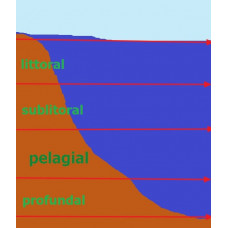Pelagial is the water column of oceans, seas and lakes. In seas and oceans it is divided into enipelagial (up to 200 m), mesopelagial (200- 1000 m), bathypelagial (up to 3000) m), abyssopelagial (up to 6000 m) and ultraabyssopelagial (over 6000 m). In lakes, the pelagial is divided into a coastal area lying above the underwater terrace, or littoral, and a pelagic area extending above the deep-water area of the central part.
Pelagic zone - an area of the sea or ocean that is not in close proximity to the bottom. Habitat of pelagic organisms - plankton, nekton, pleistone. This zone occupies 1.3 million km3 of the sea and depths up to 11 km. The pelagic zone is contrasted with the bottom zone (which includes the sea soil) and the benthic zone (which is directly above the soil) near the sea bottom, as well as the littoral zone near the coast. Fish inhabiting the pelagic zone are also called pelagic fish.
The pelagic zone extends from the sea surface and almost reaches the bottom of the sea. Conditions change quite significantly with depth: in particular, the pressure increases and the amount of light decreases.
Pelagial also has sediments in the form of mud and clay, and it is these that cover the slopes of the continents and the ocean bed. The remains of marine organisms and fine sediment particles serve to form them, as do volcanic, cosmic dust and rock fracture products on the ocean floor.
Pelagial
Tags: pelagial

